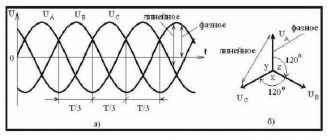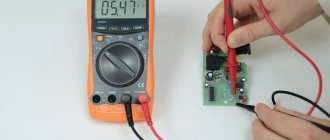Among the protective equipment designed to protect a person from possible electric shock, dielectric gloves are the most famous. They allow you to touch bare conductors and perform a number of household and industrial repairs quickly and safely. Anyone can afford gloves; they are easy to use and are an integral attribute of every electrician. However, the low level of information about dielectric gloves leads to their incorrect use, and in this article we will talk about the main points that you should familiarize yourself with.
Service life of dielectric gloves
If the storage rules are followed, dielectric gloves usually last 1 year or more (if there is a periodic inspection of the product - once every six months). The warranty period must be indicated on the packaging.
If safety precautions are not followed, a person wearing gloves may receive an electric shock, which can cause muscle spasms, difficulty breathing, and even death.
Some people's skin does not conduct electricity, so when they receive an electric shock, they do not feel any discomfort at first. However, there are signs that indicate that an electric shock has occurred and medical attention is needed. This:
- A sharp fall by an employee if he stood next to electrical appliances or electrical equipment;
- Deterioration of vision (the eye does not respond to light), speech understanding;
- Stopping breathing;
- The occurrence of convulsions, loss of consciousness.
Electric shock may cause a burn on the skin. However, if it is not there, this does not mean that everything is fine: the current may not affect the outer skin, but cause problems with breathing or heart.
It is important to immediately remove the person from the source of the electric shock, since he himself will not be able to remove his hand from the wire. To do this, you cannot use your hands; you need to use an object that does not conduct electricity. Then you need to check whether the person has a pulse and breathing. If not, you need to immediately call an ambulance and begin resuscitation (artificial respiration). It is also important to find the place where the current entered, cool it with water for 10-15 minutes, and wrap the damaged areas of the skin with clean bandages.
Requirements for rubber gloves for electricians
Dielectric gloves for currents up to 1000V and more than 1 kV have two layers of different colors. There is a number marking on the outside.
When releasing each batch, the following data must be indicated:
- Product name;
- Date of manufacture;
- Number of claws in the batch;
- Type and marking;
- Product mark;
- Expiration date and warranty.
Before use, tests are carried out on the gaiters, the results of which are noted in a special form. First, one pair is taken. If the product does not pass testing, 2 other pairs are taken from the same batch, but more in-depth testing is carried out on them. If they pass the test, it expands the usability of the entire batch; if not, the dielectric gloves are acceptable, that is, they do not meet the requirements.
If goods are transported from one climate zone to another, the batch is left for a day at room temperature and only then unpacked. During storage, dielectric gloves should not be exposed to ultraviolet rays (sunlight), and the packaging should be located at a distance of at least 1 m from heating and heating devices.
Test of strength
Testing electrically insulating gloves is a necessary measure during their use. Such a check (verification period) is carried out once every six months (the frequency of the check depends on the marking “Ev” and “En”).
Scheme for testing mittens, boots and galoshes for strength:
- 1 – test transformer;
- 2 – switching contacts;
- 3 – shunt resistance;
- 4 – gas-discharge lamp;
- 5 – ;
- 6 – ammeter (mA);
- 7 – spark gap;
- 8 – container with water.
Before starting the test, it is necessary to set the switch from the corresponding contacts to position A. This is necessary in order to establish the absence (presence) of a breakdown using signal lamps. If there is no breakdown, then the switch is moved to position B and the electric current that passes through the gloves is measured. If the passing current exceeds the norm, then such gloves are rejected. Those mittens that were rejected are strictly prohibited from being used for work! Since they will be unable to protect a person from electric shock. When the test is over, the leggings are dried.
The verification scheme may be slightly changed, but the essence remains the same. Now we will look at another test method, where we will tell you how to use the installation for testing gloves.
So, the dielectric material of the gloves can be checked using an example: water is poured into the container of the device under test and into the sample (gloves). Its temperature ranges from 10 to 40 degrees Celsius. The distance from the edge of the glove to the water should not exceed 55 millimeters. The edges of the gaiter and containers must remain dry.
The voltage that is supplied to the container body and the electrode that is lowered inside the glove has its own requirements and is equal to 6 kV. The test lasts one minute. The milliammeter should show the value of the current that passes through the guards - 6 mA.
The dielectric material from which the mittens are made must dry out after testing. To do this, they are placed in a special tank, such as shown in the photo below:
After drying, a test stamp must be placed on the electrically insulating gloves, which must indicate the date of use of the protective gloves (the date until which the material is good for). For example:
The stamp must be clearly visible and must be applied with indelible paint. Then it is necessary to enter information into a log indicating the testing of protective equipment. The log looks like this:
After completing all the listed procedures, if there is such a need, a protocol is issued indicating the inspection of electrical insulating leggings. A sample protocol looks like this:
How to store gloves?
Of course, dielectric gloves must not only be used correctly, but also stored according to the instructions. This will lead to an increase in their service life. In addition, proper storage is a necessary safety measure, which should not be forgotten when working with current. The following conditions exist for storing gloves:
• The room in which gloves are stored must be dry and well ventilated. The temperature should not exceed 25°C, but also not be below zero.
• Air humidity also matters. It should not be more than 75%.
• Under no circumstances should gloves be allowed to come into direct contact with the sun's rays.
• Gloves must be kept at a distance of more than 1 meter from heating devices, all kinds of oils, acids and alkalis. These substances can damage the material from which the gloves are made.
The six-monthly glove testing mentioned above is also of great importance. The gloves are sent to a laboratory where they are tested to ensure they meet all safety standards and regulations. For the test, it is necessary to fill a metal vessel with water. The water temperature should correspond to the room temperature. Gloves are placed in the dish with the fingers down, while they are filled with water.
Next, the gloves are tested with a special voltage device. This check lasts 60 seconds. Voltage electrodes are placed directly into the glove. If the light bulb lights up, it can be judged that the dielectric glove has lost its properties. Otherwise, a second check is carried out. Using a special ammeter, current is measured. If it does not exceed 6 mA, the gloves are allowed for further use due to their safety. If this indicator is exceeded, the gloves are considered unsuitable. After this diagnosis, the gloves must be dried. The necessary examination paperwork is completed and the next inspection date is attached to the gloves.
When working with electrical devices, the first thing a master should think about is his own safety. Products made from dielectric materials are the best that this industry has come to today. The advantages of dielectric gloves are that they are affordable and have been proving their effectiveness for several years. Using gloves in accordance with the regulations, you can achieve the maximum level of protection. And their proper storage and timely diagnostics will make their operation long-term and safe. Anyone who uses or plans to use dielectric gloves should remember this.
Classification
The modern market provides a fairly wide range of dielectric gloves to solve a wide variety of problems. Some models are designed for highly specialized industries and the national economy, others are universal and suitable for almost any equipment.
Structurally, all dielectric gloves are divided into:
- suture - a universal model that functions perfectly both in open electrical installations and in closed switchgear;
- seamless - most relevant for closed electrical installations, as they are quickly destroyed under the influence of ultraviolet radiation;
- five-fingered - used in work with complex technological operations;
- two-fingered - used in simple technological processes where a strong hand grip is required.
The main criterion for the protection of dielectric gloves is the level of operating voltage that can be touched. Therefore, for different voltage classes there is a special gradation:
- 00 – intended for household networks where the voltage does not exceed 220 V;
- 0 – for power equipment systems up to 1000 V (380 V, 600 V, 800 V);
- 1 – represent products with a tolerance level of up to 7500 V;
- 2 – glove class up to 17,000 V;
- 3 and 4 - regulated for electrical equipment where the voltage does not exceed 26,500 and 36,000 V, respectively, for each class.
In addition to classic dielectric gloves, the following types are used in practice:
- gaiter - equipped with an enlarged bell, which makes it easier to put it on a thick sleeve;
- composite – additionally protected from mechanical damage;
- contour – with widening at the wrist, making it easier to bend the arm;
- with lining – has a textile layer fixed in an elastomer;
- extended – allows you to protect your arm up to the shoulder.
Protective means in electrical installations and their types
Maintenance personnel of existing electrical installations are required to use protective equipment recommended by the electrical safety instructions, according to which all protective equipment is divided into two types.
There are different types of protective equipment
Tools and devices of the first group are able to withstand stress for a long time. This group is the main one. The use of fixed assets during work that is carried out without stress relief provides a guarantee that nothing will happen to a person during the period during which he carries out test work or repairs.
Another group includes additional means of protection. They do not provide one hundred percent protection and confidence that an electric shock will not cause an accident, and can only be used together with protective equipment of the first group, that is, with the main ones.
Protective grounding
In electrical installations up to 1000 volts (low voltage) and above 1000 volts, the same protective equipment can be used differently. In one case, it is allowed to be used as a primary means; in power plants over 1000V, this is only an additional protection measure.
The main protective elements include:
- insulating rods;
- voltage indicators;
- electrical and insulating clamps;
- locksmith tools with insulated handles;
- dielectric gloves.
This list is approved for use in power plants up to 1000V.
Note! Dielectric gloves as the main means of protection are allowed to be used only in those electrical installations where the voltage is less than 1000 V. The use of gloves in high-voltage electrical installations as a main means is not permissible!
Locksmith tools must be used with protective gloves
Additional protective measures are:
- dielectric galoshes and boots;
- dielectric mats;
- insulating stands;
- portable protective grounding;
- rods.
There is a division into means for collective and individual use (PPE). The purpose of the latter is to prevent a person from falling from a height, to protect the respiratory organs, to prevent injuries to the head, face, hands, and other parts of the body. This also includes suits that protect against electric arcs.
Important! The timing of PPE inspection is regulated by industry documents and must be observed.
Consequences for failure to comply with the rules for checking PPE
The use of PPE that has not passed periodic tests within the established time limits in accordance with GOST 12.4.307-2016 is unacceptable.
First of all, this is a direct threat to human health and life. And if an employee receives an industrial injury while using PPE that has not passed the test, the employer will face administrative liability under Article 5.27.1 of the Code of Administrative Offenses of the Russian Federation. In cases of serious harm to the health of an employee, as well as his death, due to his use of PPE that does not comply with GOST 12.4.307-2016, the employer faces criminal liability, in accordance with Article 143 of the Criminal Code of the Russian Federation.
One of the divisions of the company “METTATRON Group”
is its own electrical laboratory. Where tests are carried out on stationary stands, in strict accordance with the instructions of the Ministry of Energy of the Russian Federation. Each test of protective equipment is drawn up in a separate protocol of an approved form and certified by the signatures of responsible persons, as well as the seal of the electrical measuring laboratory.
Test frequency
Every 6 months
From the date of use, it is necessary to test gloves in specially equipped and licensed electrical laboratories.
In this case, the date of commencement of operation is considered to be the date of the last tests.
, and not the day of actual use of the product.
Information about the timing of the next test can be clarified on the stamp, which must be on gloves and other personal protective equipment.
Sample stamp for PPE testing
Principles of testing and testing periods for dielectric gloves
Safety regulations require testing of dielectric gloves every six months. Testing is carried out in laboratory conditions: first, the pair is subjected to a load of 6 kV for 60 seconds. If the products are suitable for use, they conduct no more than 6mA; if the material conducts more current, the gaiter is unsuitable for use as electrical protection.
Check sequence:
- Electrically insulating dielectric gloves are placed in a metal container with warm or slightly cool (not lower than 20 C) water. In this case, the gloves are not completely immersed - the top should look 45-55 mm above the surface. This is necessary so that electrodes can be placed inside the mittens. The material above the water (as well as the walls of the tank that are not filled with liquid) must be dry.
- One of the transformer contacts is connected to the container, the other is grounded. An electrode grounded using a milliammeter is immersed in the gloves. Thanks to this method, it is possible not only to assess the integrity of the material, but also to test whether electric current flows through the product.
- The load comes from transformer equipment, which is connected by one wire to the tank, and by the second to a two-position switch. The first test method: transformer-gas-discharge lamp-electrode chain; second method: transformer-milliammeter-electrode chain.
Features of using electrically insulating gloves
Before use, dielectric gloves should be inspected, paying attention to the absence of mechanical damage, contamination and moisture, and also check for punctures by twisting the gloves towards the fingers.
Before putting on dielectric gloves, it is necessary to inspect them, focusing on the following points:
- Verification stamp must be present
- The product must not have any mechanical damage
- Leggings should not be dirty or wet
- There should be no punctures or cracks
Almost everything here is clear and easy to evaluate visually, but how to check dielectric gloves for punctures? To do this, you need to twist the gaiters towards your fingers - the cracks will immediately become noticeable.
During use, the edges of the gloves should not be turned up. To protect against mechanical stress, you can wear leather or canvas items on top.
From time to time it is recommended to wash the used pair in a soda solution (ordinary soapy water can be used). The gloves are then dried.
Important: If dielectric gloves meet the protective properties, they can be used for six months, until the next inspection. However, before each use you need to check their condition. If cracks, mechanical damage, etc. are found, this protective agent cannot be used.











